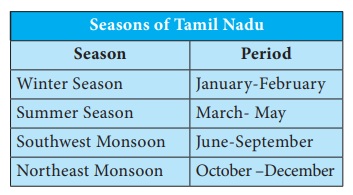Geography - Climate of Tamil Nadu | 10th Social Science : Geography : Chapter 7 : Physical Geography of Tamil Nadu
Chapter: 10th Social Science : Geography : Chapter 7 : Physical Geography of Tamil Nadu
Climate of Tamil Nadu
Climate
You have
already learnt that the Tropic of Cancer divides India roughly into two equal
parts and the state Tamil Nadu lies to the south of Tropic of Cancer, which is
near the Equator. As it receives vertical sunrays, the temperature of the state
is relatively high throughout the year. Though the state falls within the hot
climatic zone, the east coast of Tamil Nadu enjoys tropical maritime climate.
The Bay of Bengal and Indian Ocean influence the climate of the coastal regions.
While the
east coast experiences tropical maritime climate, the western region of the
state enjoys the mountainous climate. Low altitude and distance from the sea
are the reasons for high temperature and dry conditions in the central part of
Tamil Nadu. The migration of vertical sun’s rays leads to the formation of
different seasons in Tamil Nadu as follows.

Winter Season
During
January and February, the vertical rays of the sun fall between the Tropic of
Capricorn and the Equator. Hence, Tamil Nadu and India on the whole receive
slanting rays from the sun. So, the weather is slightly cooler during these
months. Winter temperature in Tamil Nadu varies from 15°C to 25°C. However, in
the hill stations, the winter temperature drops below 5°C occasionally. Some
valleys in the Nilgiris record even 0°C. This drop in temperature leads to the
formation of thick mist and frost. This season is practically dry.
Summer Season
The
apparent migration of the sun towards north during March, April and May results
in the reception of vertical sun’s rays by South India. Thus there is a steady
rise in temperature from the equator. Hence, Tamil Nadu located to the south of
Tropic of Cancer, experiences high temperature. Generally the temperature
varies from 30°C to more than 40°C. During this season particularly in the
month of May, southern part of the state receives some rainfall from pre-
monsoon showers (Mango/ Blossom showers) and some parts experience convectional
rainfall.
1. What is Agni Nakshatram?
2. Group the districts of Tamil Nadu into low, moderate and
heavy rainfall regions.
Southwest Monsoon
The
intense heating of the landmass of the north by the sun during March to May
creates a well-developed low pressure in North India, which draws wind from the
Indian Ocean. This results in the formation of southwest monsoon. During this
season, Tamil Nadu is located in the rain shadow region for the wind, which
blows from the Arabian Sea. As a result, Tamil Nadu receives only a meagre rainfall
from this monsoon. Rainfall during this season decreases from west to east.
Coimbatore plateau receives an average of 50 cm rainfall. However, the southern
districts like Kanyakumari, Tirunelveli and The Nilgiris record 50–100 cm
rainfall during this period. The rainfall is scanty in the eastern part of the
state.
Northeast Monsoon
The
northeast monsoon season commences from the month of October and lasts till
mid-December. The high pressure created over Central Asia and northern part of
India becomes the source for the northeast monsoon winds. The apparent
migration of the sun from Tropic of Cancer to the Tropic of Capricorn causes a
change in receiving temperature and air pressure during this season. It makes
the wind to blow towards Bay of Bengal from North India and get deflected by
Coriolis force and takes the northeast direction. Hence it is known as
northeast monsoon. As the northeast monsoon is a part of returning of southwest
monsoon wind, it is also called as the retreating monsoon. This is the main
rainy season for Tamil Nadu, accounting for its 48% of annual rainfall.
Coastal
districts of the state get nearly 60% of their annual rainfall and the interior
districts get about 40–50% of the annual rainfall during this season.
Tropical
cyclones are common during this season. Cyclone originating from the Bay of
Bengal bring heavy rainfall to the east coastal regions of Tamil Nadu. More
than 50% of the state’s rainfall is received from tropical cyclones during this
period and east coastal region receives 100 to 200 cm of rainfall. The rainfall
received by the central and northwestern parts is 50–100 cm. The cyclones
sometimes disturb the cultivation of crops and cause severe damage to life and
property.
Chinnakallar near Valparai is the 3rd
wettest place in India and the wettest place in Tamil Nadu.
Related Topics